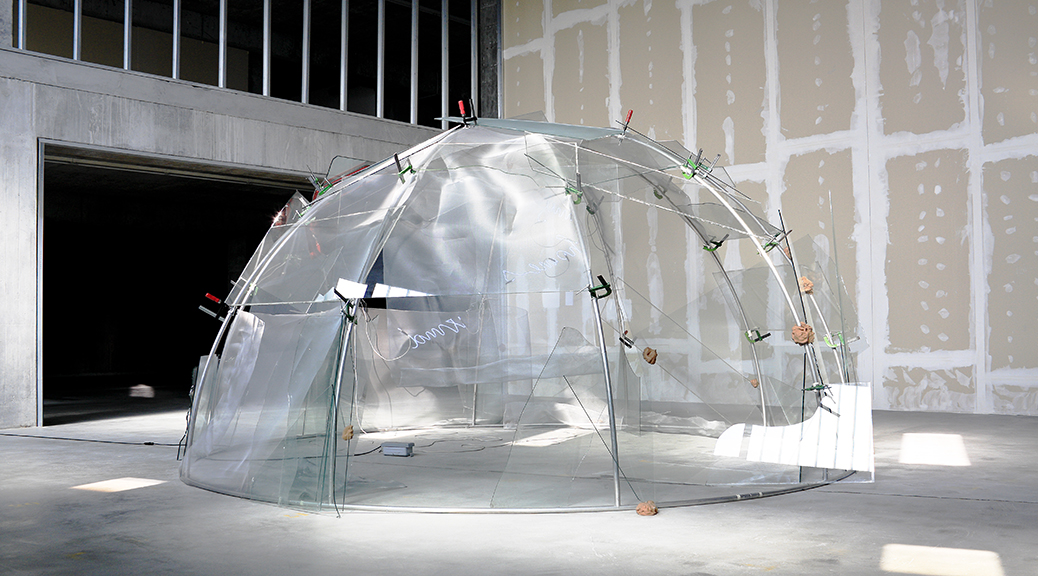Mario Merz
My home’s wind, 1978
Mario Merz hat immer wieder Häuser gebaut – oft in der organischen Form von Iglus und Jurten. Er hat dafür meist Materialien ohne offensichtlichen Wert verwendet, Gefundenes, Steine, Reisig, Glas. Wie ein Nomade hat er die Stücke übereinander geschichtet, ohne sie fest zu fixieren – immer so, dass die Häuser wieder abgebaut und woanders neu errichtet werden können. Seine Iglus haben auf der ganzen Welt das Bild geprägt, das sich mit Merz’ Kunst verbindet. Doch wie unterschiedlich und subtil Merz die elementare Form nutzte und wie vielseitig die Bedeutungen sind, die er ihr gab, ist in dem Reichtum der vielen Varianten erst noch zu entdecken.
Merz war ein kluger und empfindlicher Mann, der sein Leben lang versuchte, der gesellschaftlichen Oberflächlichkeit mit Inhalten und Phantasie entgegenzuwirken. Sein Iglu mit dem Titel „My home’s wind“ ist das Meisterstück eines poetischen Bildes und hat alle Züge einer magischen Situation. Das ganze Gebilde ist von einer Leichtigkeit, die an Auflösung grenzt und sich als Stimmung zwischen Befreiung und Melancholie überträgt. Das Prinzip der Offenheit hat hier seine Metapher gefunden, und die Bewegung des Windes gewinnt sinnliche Qualität. Ich selbst bewege mich mit dem Wind, der aus der Vergangenheit kommt und mich in die Zukunft trägt. Ich spüre die geistige Freiheit, die er mit sich führt und erfahre die Durchsicht als Lebensgefühl.
Es ist diese physische Intensität, die dem Werk von Mario Merz eine besondere Präsenz verleiht. Mit ihr verbunden ist ein Gehalt, der wie ein Rätsel den Schlüssel zu seinem Verständnis nicht sogleich mitliefert. Das steigert die Faszination eines Werks wie „My home’s wind“. Merz schafft dem Menschen einen Ort in der Zeit, ohne ihn dort zu verankern. Der Eingang zu diesem Ort kann auch vom Boden abgehoben sein – wie die rote Autotür dieses filigranen Iglus.
Die Publikation “My home’s wind” ist 2011 im Rahmen unserer Mario Merz Series erschienen.Mario Merz
My home’s wind, 1978
Mario Merz built houses repeatedly – often in the organic form of an igloo or yurt. He usually used materials without obvious intrinsic value: found objects, stones, deadwood and glass. He layered the pieces on top of one another like a nomad, without fixating them, so that the houses could be taken apart again and re-erected at a new site. His igloos have shaped the image of Merz’s art all over the world. However, the variability and subtlety Merz employed in this elementary form, and how diverse the meanings are that he gave them, can only be discovered in the wealth of the many versions he created.
Merz was an intelligent and sensitive man who spent his life trying to confront social superficiality with contents and fantasy. His igloo titled “My home’s wind” is a masterpiece of poetic imagery and has all the characteristics of a magical situation. The entire construct has a lightness that bor- ders on the ephemeral and transports an atmosphere that lies between liberation and melancholy. The principle of openness has found its metaphor here, and the wind’s movement attains a sensual quality. I move with the wind that originates in the past and carries me into the future. I sense the spiritual freedom that it conveys, and I experience the clarity as an approach to life.
It is precisely this physical intensity that gives Mario Merz’s work a special presence. A substance is found here that, like a puzzle, doesn’t immediately provide the key to understanding. This increases the fascination for a work such as “My home’s wind”. Merz creates a location in time for people, without anchoring them there. The entrance to this location can also be hovering above the floor – like the red car door in this filigree igloo.
The publication “My home’s wind” (2011) is also part of our Mario Merz Series.
